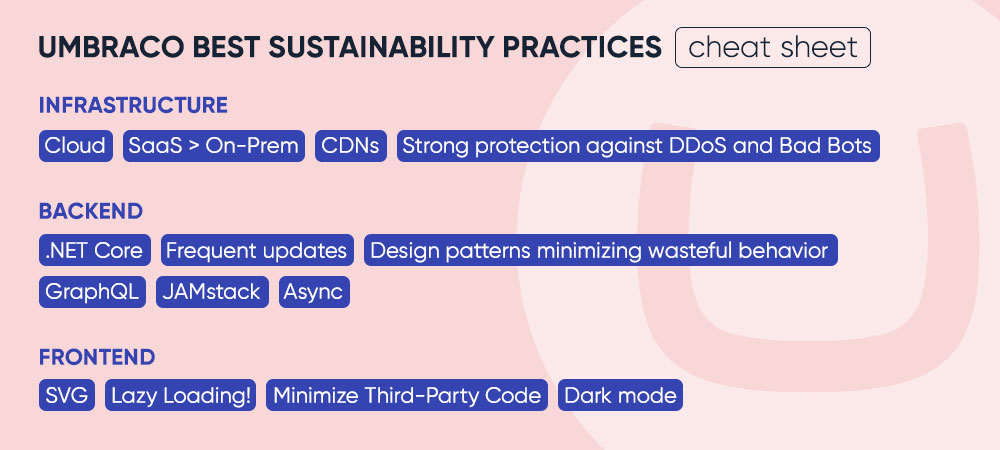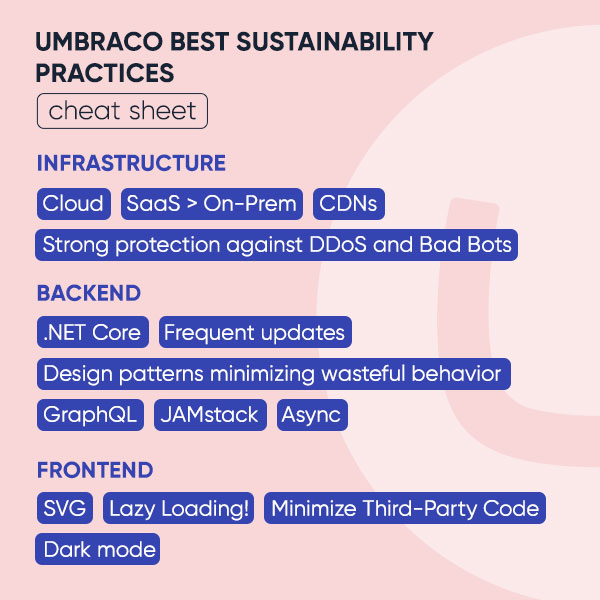Umbraco is dedicated to becoming the most environmentally friendly CMS on the market. And that's good not just for the environment but also for the business since what's considered "greener" in the digital world also happens to be more efficient and user-friendly.
"Used wisely, digital could be saving our planet, making things more productive and efficient, and more environmentally friendly, while improving living standards. Right now, however, digital is killing our planet". That's a direct quote from the introductory chapter of "World Wide Waste" book, which was referred to a couple of times during the "Umbraco Best Sustainability Practices" webinar.
Some time ago, we penned a brief article discussing how "digital is physical", emphasizing that the data exchange between your device and servers results in actual energy consumption and, consequently, utilizes tangible Earth resources. The book mentioned earlier delves extensively into this topic and offers practical solutions. In line with these principles, Umbraco demonstrates how to implement many of these solutions. The platform provides recommendations, some of which we actively incorporate (or will be) into our work on clients' websites. Here are some of the essential Sustainability Practices.
Choosing your infrastructure
In the digital world, the amount of energy consumed and, therefore, carbon dioxide emitted depends mainly on the amount of data transferred between the device sending the query and the hosting provider's infrastructure, which stores the answer in the form of content on our website. Therefore, the choice of hosting provider is critical. The selection of a hosting provider plays a pivotal role in this context.
Going Cloud First is a good idea in general since all major cloud providers, including Microsoft (which pledged to go carbon-negative by 2030), have net zero commitments.
- Best infrastructure-related practices supported by Umbraco include:
- Choosing SaaS rather than On-Premise services (any solutions that eliminate the need for organizations to purchase and maintain a lot of physical hardware on-site and allow people to work from anywhere).
- Utilizing CDNs and efficiently distributing and delivering content from servers strategically located worldwide (again, it minimizes the need for long-distance data transfers).
- Protecting vigorously against DDoS attacks and unwanted bot traffic (according to most statistics, malicious traffic accounts for over 70% of all network traffic).
- Turning off the non-production environment when not used.
Sustainable Backend Development
There's quite a range of things you can do regarding the backend, starting with simply keeping your system up to date at all times. Consider this:
- Using .NET Core's newest technologies, which Umbraco's latest versions are all built on, significantly affects efficiency.
- Leveraging caching correctly reduces the need for repeated data transfers, decreasing server load and energy consumption.
- Choosing design patterns that prevent systems from continuously trying to execute an operation likely to fail and allow them to handle errors more gracefully.
- Keeping your APIs clean and lean with the help of technologies like GraphQL.
- Leveraging asynchronous programming allows systems to perform multiple tasks concurrently without waiting for each to complete, enhancing efficiency by enabling overlapping execution of functions and minimizing idle time.
Frontend
The optimal practices for frontend sustainability primarily revolve around conscientiously managing your website's resource load. A strategic approach involves setting a page-weight budget right from the project's inception, facilitating smoother progress through the following.
- Opt for contemporary image formats, with a special emphasis on SVG for icons.
- Leverage the latest Umbraco 13 features, including built-in lazy-loading solutions to enhance performance.
- Minimize reliance on third-party code, a potential culprit for nearly half of all web requests, thereby streamlining your website's efficiency.
- Make judicious choices in color schemes, incorporating subdued tones. Additionally, consider implementing dark mode, a feature that markedly reduces energy consumption on devices displaying your content.
You can watch the entire webinar here:
Explore further insights into Umbraco Sustainability Practices and the upcoming Sustainability Package designed to monitor crucial site parameters influencing CO2 consumption. For in-depth information, visit our partner's website.
You want make your website more carbon-efficient? Let's talk about it.



 "Used wisely, digital could be saving our planet, making things more productive and efficient, and more environmentally friendly, while improving living standards. Right now, however, digital is killing our planet". That's a direct quote from the introductory chapter of "World Wide Waste" book, which was referred to a couple of times during the "Umbraco Best Sustainability Practices" webinar.
"Used wisely, digital could be saving our planet, making things more productive and efficient, and more environmentally friendly, while improving living standards. Right now, however, digital is killing our planet". That's a direct quote from the introductory chapter of "World Wide Waste" book, which was referred to a couple of times during the "Umbraco Best Sustainability Practices" webinar.